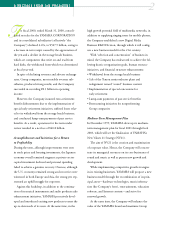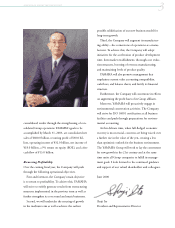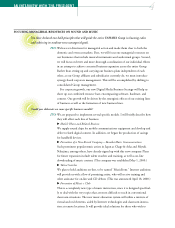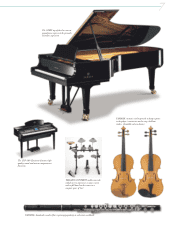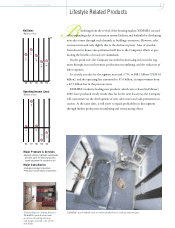Yamaha 2000 Annual Report Download - page 4
Download and view the complete annual report
Please find page 4 of the 2000 Yamaha annual report below. You can navigate through the pages in the report by either clicking on the pages listed below, or by using the keyword search tool below to find specific information within the annual report.
2
A MESSAGE FROM THE PRESIDENT
In fiscal 2000, ended March 31, 2000, consoli-
dated net sales for the YAMAHA CORPORATION
and its consolidated subsidiaries (collectively “the
Company”) declined 6.4%, to ¥527.9 billion, owing to
a decrease in net receipts caused by the appreciation of
the yen and a decline in the storage heads business,
which are components that write on and read from
hard disks, the withdrawal from which was determined
at fiscal year-end.
In spite of declining revenues and adverse exchange
rates, Group companies, most notably overseas sub-
sidiaries, produced strong results, and the Company
succeeded in recording ¥8.1 billion in operating
income.
However, the Company incurred extra retirement
benefit disbursements due to the implementation of
special early retirement initiatives; suffered losses relat-
ed to its withdrawal from the storage heads business;
and conducted lump-sum payments of past service
benefits. As a result, operations for the term under
review resulted in a net loss of ¥40.8 billion.
Accomplishments and Initiatives for a Return
to Profitability
During the term, although improvements were seen
in stock prices and housing investments, the Japanese
economy overall remained stagnant as private-sector
capital investment declined and personal spending
failed to achieve a genuine recovery. Overseas, although
the U.S. economy remained strong and recoveries were
witnessed in both Europe and Asia, the strong yen rep-
resented an uphill struggle for exporters.
Against this backdrop, in addition to the continua-
tion of its musical instruments and audio products sales
enhancement initiatives, YAMAHA proactively devel-
oped and introduced exciting new products to meet the
up-to-date needs of its users. At the same time, in the
high growth potential field of multimedia networks, in
addition to supplying ringing tones for mobile phones,
the Company established a new Digital Media
Business R&D Division, through which it will config-
ure a new business model for the 21st century.
With “selection and concentration” of business in
mind, the Company has endeavored to achieve the fol-
lowing drastic reorganization goals, human resource
initiatives, and financial structure enhancements:
• Withdrawal from the storage heads business
• Sale of the Tenryu semiconductor plant and
realignment toward “sound” business content
• Implementation of special concessions for
early retirement
• Lump-sum payments of past service benefits
• Restructuring initiatives for nonperforming
Group companies
Medium-Term Management Plan
In December 1999, YAMAHA drew up its medium-
term management plan for fiscal 2001 through fiscal
2003, which will see the finalization of YAMAHA’s
New Values 21 Strategy (NV21).
The aim of NV21 is the creation and maximization
of corporate value. Hence, the Company will concen-
trate its managerial resources on its core businesses of
sound and music as well as pursue new growth and
development.
While implementing competitive growth strategies
in its existing businesses, YAMAHA will propose a new
business model through the recombination of its prin-
cipal assets—hardware technologies, music informa-
tion (the Company’s forte), entertainment, education
software, and Internet content—and strive for
renewed growth.
At the same time, the Company will enhance the
value of the YAMAHA brand and maximize Group




